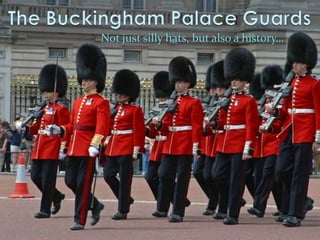
Uk21
- 1. Not just silly hats, but also a history…
- 2. Summary Buckingham Palace Guards / Queen’s Guards. Who are they? Identifying the regiments Changing the guard The mystery behind the hat Conclusions
- 3. Buckingham Palace Guards a.k.a. Queen’s Guards The Queen's Guard is the name given to the contingent of infantry responsible for guarding Buckingham Palace and St. James's Palace (including Clarence House) in London. The guard is made up of a company of soldiers from a single regiment, which is split in two, providing a detachment for Buckingham Palace and a detachment for St James's Palace. Because the Sovereign's official residence is still St James's, the guard commander (called the 'Captain of the Guard') is based there. The Queen's Guard is not purely ceremonial in nature. They provide sentries during the day and night, and during the latter hours they patrol the grounds of the Palace. Until 1959, the sentries at Buckingham Palace were stationed outside the fence. This stopped following an incident involving a female tourist and a Coldstream Guardsman — due to the continued pestering of tourists and sightseers, the guardsman kicked the tourist on the ankle as he marched. The tourist made a complaint to the police and, despite sympathy, the sentry was confined to barracks for ten days. Not long after, the sentries were moved inside the fence.
- 4. Identifying the Regiments Blues & Regiments Life Guards Grenadier Coldstream Scots Irish Welsh Royals worn on the worn on the worn on the worn on the Plume on helmet on helmet None left right right left. White/Gree Plume White Red White Red None Blue n/ colour White Buttons None None Singly Pairs Threes Four Fives Tunics Red Blue Red Red Red Red Red Metal Metal Bearskin Bearskin Bearskin Bearskin Bearskin Head wear helmet helmet cap cap cap cap cap
- 5. Changing The Guard This colorful ceremony is one of the 'must sees' on a trip to London. Each regiment has a different “way” of changing its shifts. For example: The Queen’s Life guards change more seldom than the foot guards, and that happens with a big ceremony. The foot guards are the only ones situated outside the walls. When the queen is home, there are four of them surrounding the palace, but when she’s out, there are only two in front of it. Most of the guards, today, are only held for ceremonial purposes.
- 6. Life Guards Identification: Metal helmets On horse No buttons Metal amour Located inside the walls of the palace
- 7. Foot Guards Identification: Bearskin hat On foot Pairs of buttons No armor Located outside the walls of the palace
- 8. The mystery behind the hat The 50 cm tall bearskins worn by the foot guards are made out of real Canadian brown bears and weigh around 0,700 g. They were worn first in 1815 by British soldiers, following the defeat of Napoleon’s French Imperial Guards at the battle of Waterloo. The French grenadiers wore the hats to appear taller and more intimidating, and Britain adopted the towering hats as a symbol of victory.
- 9. Conclusions As you can see, these famous soldiers mean a lot more than a tourist attraction. There are different kinds of regiments, each with their separate purpose. The myth about them not being allowed to move is partially true. Yes, traditionally, they are not supposed to move, but they still move in and out of the sentry box once in every 10 minutes. They are more of a kind of patrolling police officers than unmovable bodyguards. A guardsman spends two hours on duty and four out, and he is expected to stand still only 10 minutes at a time, thus, the myths about the difficultness of this job are discarded.